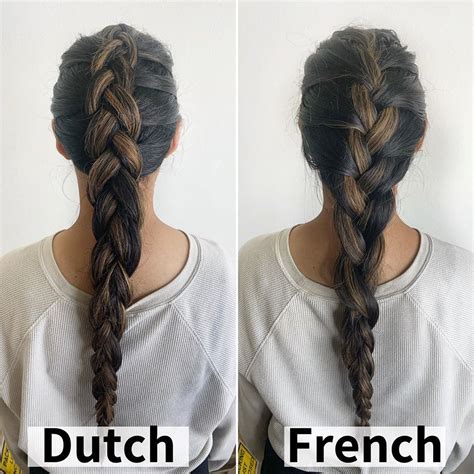Introduction

Braiding is an ancient art form that has been practiced for centuries. French and Dutch braids are two of the most popular braiding techniques, but they differ in several key ways. This comprehensive comparison will explore the similarities and differences between these two braiding styles, providing you with the information you need to choose the right braid for your hair and style.
Similarities between French and Dutch Braids
- Three-Strand Foundation: Both French and Dutch braids are constructed using three strands of hair.
- Overlapping Pattern: In both braiding techniques, the strands are crossed over each other in an overlapping pattern to create the braid.
- Tight Hold: Both French and Dutch braids provide a secure hold, making them ideal for keeping hair in place for long periods.
Differences between French and Dutch Braids
Construction:
- Starting Point: French braids start at the crown of the head, while Dutch braids start at the nape of the neck.
- Strand Crossing: In a French braid, the strands are crossed over each other from the outside to the inside. In a Dutch braid, the strands are crossed over from the inside to the outside.
- Appearance: French braids have a raised, textured appearance, while Dutch braids have a flatter, more seamless look.
Suitable Hair Types:
- French Braids: Suitable for all hair types, including fine, thick, or curly hair.
- Dutch Braids: Ideal for thick or curly hair as they provide a stronger hold.
Maintenance:
- Durability: French braids typically last longer than Dutch braids due to their tight construction.
- Ease of Removal: Dutch braids are easier to remove than French braids because the strands are less tightly intertwined.
Which Braid is Right for Me?
The choice between a French braid and a Dutch braid depends on your personal preferences, hair type, and desired style.
- French braids: Ideal for a more casual, romantic look. Suitable for all hair types.
- Dutch braids: Perfect for a sleek, sophisticated look. Ideal for thick or curly hair.
Benefits of French and Dutch Braids
- Secure Hold: Both French and Dutch braids provide a secure hold, making them ideal for keeping hair in place during activities or windy conditions.
- Versatile Styling: These braids can be styled in various ways, from buns to ponytails.
- Hair Protection: Braiding can protect hair from breakage and damage caused by heat styling and environmental factors.
Tips and Tricks for Braiding
- Use a brush or comb: Brush your hair thoroughly before braiding to remove tangles.
- Section your hair: Divide your hair into three sections to make braiding easier.
- Tighten the strands: Keep the strands tight as you braid to create a secure and polished look.
- Use hairspray: Spritz your braid with hairspray to hold it in place.
- Practice makes perfect: The more you braid, the better you will become at creating beautiful braids.
Creative Applications
Beyond traditional braiding, French and Dutch braids can also be used for a variety of creative applications, such as:
- Headbands: Braid a French or Dutch braid around your head for a unique and stylish headband.
- Jewelry: Incorporate beads or other embellishments into your braid for a touch of glamour.
- Accents: Add a braid to your ponytail or bun to add interest and detail.
Conclusion
French and Dutch braids are versatile and beautiful braiding techniques that can enhance any hairstyle. By understanding the differences between these two styles, you can choose the right braid for your hair and occasion. With a little practice and creativity, you can master the art of braiding and create stunning hairstyles that will turn heads.
